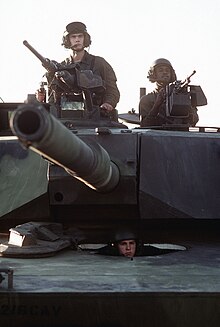Ancillary weapon

Anancillary weapon(also known as asecondary weapon,auxiliary weapon,orbackup weapon) is aweaponused to supplement a primary or main weapon in the event it cannot be used or is ineffective in a certain application or situation. Examples of ancillary weapons to main weapons include amelee weaponto aranged weapon,asidearmto aservice weapon,or a lightgunto a heavycannon.
Overview[edit]
Ancillary weapons are intended to supplement a main weapon, and may be used either when the main weapon becomes inoperable temporarily (e.g. depletingammunition) or completely (e.g. being destroyed), or when the main weapon is unsuitable for the current situation (e.g. along guninclose-quarters combat). Ancillary weapons typically have lowerfirepoweroreffective rangesthan the main weapon, due to them being intended for emergencies or when necessary and not for regular service. They may be weapons that were historically considered main weapons but are no longer effective in those roles, such as swords when firearms became the primary infantry weapon in warfare.
Ancillary weapons do not have to be actual weapons and may technically includeimprovised weaponry,especially when no other ancillary weapons are issued or effective. For example, duringWorld War I,utility knivesandentrenching shovelswere used as ancillary weapons duringhand-to-hand combatintrenches,where rifles and fixed bayonets were too long to be used effectively.[1]By 1915, soldiers on both sides routinely sharpened the edges of entrenching shovels for use as weapons.[2]
Examples[edit]
A simple example of an ancillary weapon is abayonet,a bladed weapon mounted to the front of a firearm. Bayonets were widely issued when service weapons were long guns that were impractical for close combat, such asmusketsandbolt action rifles,and they were often the only ancillary weapon available for soldiers that were not issued sidearms, such asriflemen.Most bayonets can also be used on their own as acombat knife.
"Underbarrel" or "underslung" weapons—those installed on the lowerbarrel shroudorrail integration system,such as underbarrelgrenade launchersorshotguns—are examples of ancillary weapons used in conjunction with a main weapon rather than as a backup weapon: underbarrel grenade launchers are used to provideexplosive weaponsupport where a conventionalhand grenadewould not reach its target or take too long to use, while underbarrel shotguns are used indoor breachingor close-quarters combat.
Traditionally,military officerscarry a sidearm. This was historically some form ofswordordaggeruntil the 19th century, when such melee weapons became ineffective and were replaced by arevolverorpistol.SinceWorld War II,when weapons with lowrates of firebecame increasingly ineffective in combat, most military officers are issued asemi-automatic pistolas a sidearm.
Many militarycombat vehiclesandaircraftare often equipped with ancillary weapons.Tanksare armed with a large-calibertank gunas their main weapon, but most tanks also have acoaxialor top-mountedmachine gunturret to be used againstinfantryor unarmored vehicles where using a tank round would be considered excessive or wasteful.Fighter aircraftcarry armaments such asmissiles,rocket pods,andaerial bombsas their main weapons, and most fighters also have anautocannonor high-caliber machine gun as an ancillary weapon fordogfightsorstrafing.Bomberscarry hundreds of aerial bombs as their main weapons, but older bombers also hadtail gunnerturrets to defend against enemy aircraft.Naval vesselswith certain main weapons may also have certain ancillary weapons to be used against specific targets; for example, a vessel withnaval gunsas main weapons may also havetorpedoesanddepth chargesfor use againstsubmarines,orvertical launching systemsfor launching missiles against aerial or land targets.
Somelaw enforcement officersandsecurity guardsthat are already armed with a main weapon (often ahandgun) may carry a smaller backup handgun, often in a lower caliber and/or with less ammunition capacity than their main handgun, in the rare event their main handgun is unavailable (e.g. stolen by a suspect). They may also use their issued main handgun as an ancillary weapon if they are authorized to use a long arm, such as a rifle orshotgun.Additionally, many police officers carryless-lethalancillary weapons such as aTaser,pepper spray,orbatons.
References[edit]
- ^Beith, Ian H. (Capt.),Modern Battle Tactics: Address Delivered April 9, 1917,National Service (June 1917), pp. 325, 328
- ^Ian Drury (1995).German Stormtrooper 1914–18.Osprey Publishing. p.61.ISBN978-1-85532-372-8.


